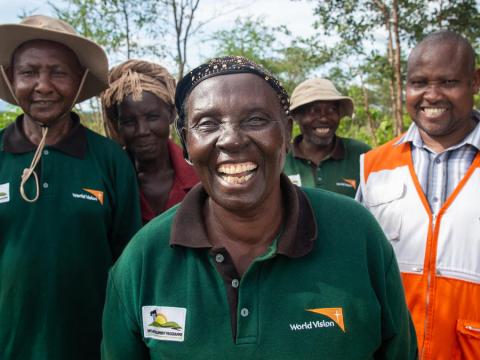Six ways we are addressing climate change around the world

This article looks at six ways World Vision programmes are addressing climate change around the world.
By Angeline Munzara, Global sector leader, Livelihoods and Yukiko Yamada Morovic, Technical Director, External Engagement and Programming, Livelihoods
The climate crisis is affecting everyone, but the most vulnerable children – those living in poverty affected communities – will bear the brunt of the impacts despite being the least responsible for it. We believe that every child has the right to both a healthy and safe environment today and a sustainable future. There is no time to waste, and children are asking us to act now. Here are six ways that World Vision is tackling the climate crisis.
1. Restoring natural environments
World Vision is a global leader in integrating community development with ecosystem restoration for the most vulnerable communities. Farmer Managed Natural Regeneration (FMNR) is a community-led nature-based solution that reverses environmental degradation and tackles poverty, hunger and climate change through the regeneration of trees and shrubs. The Humbo forestry project, a community-managed reforestation initiative in southwest of Ethiopia, has regenerated 2,728 hectares of degraded land. The project has sequestered 181,000 tCO2 to date and the sale of carbon credits has generated income for local communities. The restored landscape has also helped to strengthen livelihoods in the local community through increased grass cover for livestock, increased availability of firewood, improved ground water and decreased erosion. As we support the restoration of landscapes, we see the restoration of hope for communities who once felt powerless in the face of climate change.
2. Reducing climate risks and responding to natural disasters
The climate crisis is increasing severe droughts and floods, risking the lives and livelihoods of millions around the world. In response, World Vision partners with vulnerable children, families, and communities to reduce their exposure to climate risks through a community-led approach to Disaster Risk Management. And when disasters hit, World Vision rapidly responds to provide urgent lifesaving assistance and support the recovery of disaster-affected girls, boys, women and men. To complement our community-based approach, we invest in strengthening early warning systems to support more effective disaster preparedness and response. In 2020, World Vision provided humanitarian assistance to 27.1 million people through 66 emergency responses in 58 countries.

3. Building climate-smart livelihoods and green jobs
World Vision is supporting a Green Recovery from COVID-19 because we cannot mitigate future crises without addressing climate change and taking actions to eradicate poverty and inequality. We support sustainable economic activities by helping to protect and rebuild livelihoods in ways that consider climate risks and climate-smart outcomes. We promote sustainable natural resource management, complemented by climate-smart agricultural approaches and development of inclusive market systems to strengthen sustainable agricultural production and market access. Eco-friendly villages in Bangladesh is a great example where eco-villagers seek alternatives to ecologically destructive electrical, water, transportation, and waste-treatment systems to build more socially, economically, and ecologically sustainable communities.

4. Supporting children’s participation
Children have already shown their incredible capacity to mobilise for issues they believe in. They shared with us their concerns on the climate crisis. World Vision believes that creating spaces for children’s activism has a transformative impact on their lives and has the power to change society for the better. In Tanzania, World Vision is engaging youth from the coastal region in taking urgent actions to combat climate change and its impact on their community, through the SAUTI Youth Project. We are committed to empowering girls and boys as agents of change, and ensuring their active participation and opinions are reflected in climate action decision-making at the local, national and global levels.

5. Advocating for greater climate action
Limiting global warming to 1.5˚C will take an enormous effort and we cannot do it alone. World Vision will continue to work with our partners at the local, national, and global levels. Through global coalitions and campaigns for greater climate action to meet these targets, such as the ReGreen the Globe Movement, the UN Decade on Ecosystem Restoration, and the UNEP Faith for Earth, we seek to scale up ecosystem restoration and mitigate climate change. We also work with faith-based organisations – as more than 85 per cent of the world is religious, faith leaders have a huge influence to encourage local and global actions to tackle climate change.
6. Reducing our own environmental impact
We all have a responsibility to reduce our environmental impact and protect and care for God’s creation. We are taking action to reduce our environmental and carbon footprint by incorporating environmentally sound practices and policies in all our offices and operations. Our Environmental Stewardship Management Policy creates awareness on environmental sustainability of nearly 35 000 staff, over 112,000 volunteers and a network of 450,000 faith leaders to encourage individual and collective action for both World Vision staff and global citizens.
Find out more about our best ‘green’ practices!